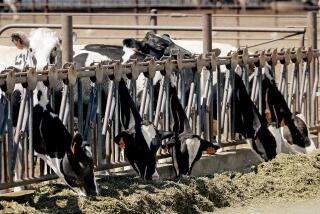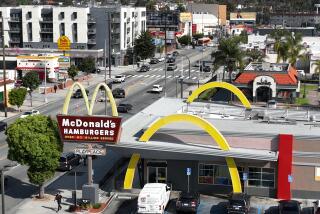Fruit and vegetable prices going up as California drought continues
Fresh fruits and vegetable prices will go up an estimated 6% in the coming months, the federal government said Wednesday, as California’s ongoing drought continues to hit price tags in grocery stores across the country.
“You’re probably going to see the biggest produce price increases on avocados, berries, broccoli, grapes, lettuce, melons, peppers, tomatoes and packaged salads,” said Timothy Richards, a chair at the Morrison School of Agribusiness at Arizona State University.
In its monthly report on the food price outlook, the U.S. Department of Agriculture said the price of fruit and vegetables will continue to rise.
As farmers continue to battle for water in the summer months, The USDA’s Economic Research Service reported that California’s drought has the potential to increase food price inflation above the historical average in coming years.
Although the department is sticking with its overall forecast that U.S. food prices will increase by up to 3.5% this year over last, it cautioned that the cost of meat, dairy, fruit and vegetables will jump.
California farmers produce half of the nation’s fruits and vegetables, and most of its high-value crops such as broccoli, tomatoes and artichokes.
But the rising cost of water has forced farmers to idle about 500,000 acres of land and produce less, making certain foods more expensive.
“Lettuce prices increased the most and that’s a direct result of the California drought,” said Annemarie Kuhns, an economist with the USDA. “Almost 70% of the nation’s lettuce is grown in California.”
The department now expects 2014 U.S. fresh fruit prices to jump by up to 6%, up from its May projection of about 4%. A devastating citrus disease in Florida also sent citrus prices up 22.5% this year.
Consumers will also see a bump in dairy prices due to increased demand.
Drought conditions in states like Texas and Oklahoma have also driven up beef prices 9% this year, and the department expects that hike to continue.
“The drought in 2012 damaged a lot of feed crops,” Kuhns said. “As a result we have the lowest herd size in the U.S. since 1951.”
California’s three-year drought is also affecting staple crops such as rice, which could also cost 10% to 20% more this year, said Daniel Sumner, director of the Agriculture Issues Center at UC Davis.
Swelling prices have been an ongoing trend after the parched state survived its driest year on record.
Food prices rose half a percent in May, the largest hike since August 2011, according to the U.S. Labor Department, and California farmers expect the hikes to continue.
“Consumers will see rising food prices because farmers have had to significantly curtail production due to lack of water,” said April Mackie, an advisor for the American Farm Bureau.
Mackie also works for a large, 7,500-acre strawberry and vegetable farm in Salinas, Calif. She said the drought will boost the prices of her crops next season, and Americans should expect to pay more for fresh food as the years go on.
“We are seeing issue with the water levels within our wells, so we will have to plant less crops next season and that’s what increases U.S. prices,” said Mackie.
The Salinas farm planted more strawberries this season because they use less water, cutting production of lettuce, broccoli and other veggies by 25%.
“We have conservatively projected that the average American family will spend about $500 more on food this year because of the drought,” said Paul Wenger, president of the California Farm Bureau. “But with what we are hearing from farmers, we expect that number to go up.”
Follow @bri_sacks for food-business news.
More to Read
Inside the business of entertainment
The Wide Shot brings you news, analysis and insights on everything from streaming wars to production — and what it all means for the future.
You may occasionally receive promotional content from the Los Angeles Times.










